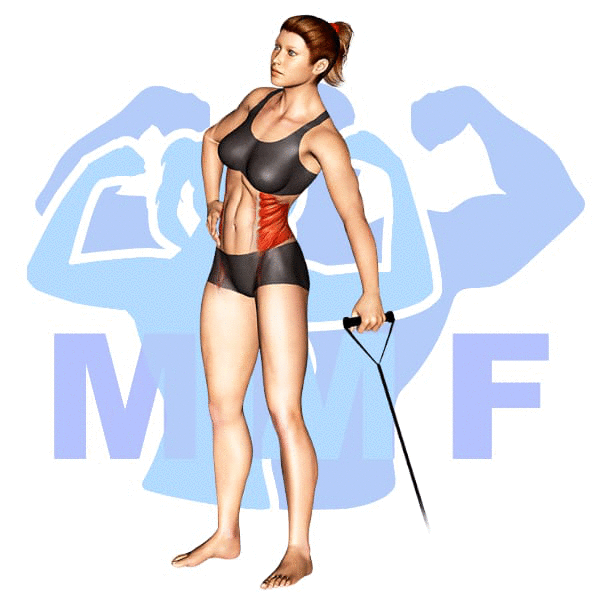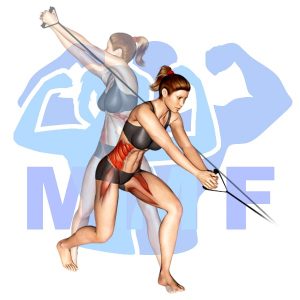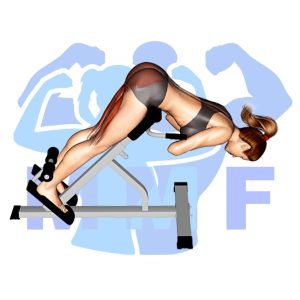Are you tired of desperately trying to tone those stubborn love handles and slim down your waistline, but seeing little to no progress? Don’t worry, you’re not alone! Many of us struggle with this problem, especially when traditional exercises like crunches and planks just don’t seem to be enough. The good news is that incorporating resistance band side bends into your workout routine can target those hard-to-reach areas and give you the results you’re looking for. In this post, we’ll discuss the benefits of resistance band side bends and how to properly execute them for optimal effectiveness. So, say goodbye to frustration and hello to a slimmer, more toned waistline with resistance band side bends!
Resistance Band Side Bends Summary
- Primary Muscles: Obliques
- Secondary Muscles: Iliocastalis lumborum, Iliocastalis thoracis, Psoas major, and Quadratus lumborum
- Equipment: Resistance Band and Door Anchor
- Mechanics Type: Isolation
- Force: Pull
- Utility: Auxiliary

Resistance Band Side Bends Instructions
- Attach the resistance bands to a good anchor point close to the base of the floor.
- Grab the resistance band handles with both hands, or you can put both handles in the one hand that will be towards the anchor point
- Stand perpendicular to the anchor point and allow the band to pull you over at the hips sideways in a side bend.
- Then once you have reached your maximum stretch, pull your body back to vertical.
- Repeat these side bends for 8-12 reps, then switch sides
Video Tutorial
Resistance Band Side Bends Muscles
Target (Agonist)
Synergists
- Iliocastalis lumborum
- Iliocastalis thoracis
- Psoas major
- Quadratus lumborum
Dynamic Stabilizers
- None
Stabilizers
- Gluteus Medius
- Gluteus Minimus
- Levator Scapulae
- Trapezius – Middle
- Trapezius – Upper
Antagonist Stabilizers
- None

Benefits of Resistance Band Side Bends
Resistance Band Side Bends are an effective way to target the obliques and strengthen your core. This exercise helps you build strength and stability in your trunk, which helps to improve balance and posture. By engaging the obliques, you are also working to improve your overall coordination and reduce the risk of injury. Additionally, Resistance Band Side Bends are a great way to tone and shape the waistline, giving you a more toned and sculpted appearance.
Tips for Performing Resistance Band Side Bends
In order for you to get the right improvement, adhere to these basic tips. Similarly, if you need to minimize the chance of injuries, stick with these tips.
- Complete The Appropriate Amount Of Sets Using Rest. Your goal at first might be to do 3 sets to near fatigue. However, you can raise to 5 sets. If your muscle tissue isn’t exhausted at the conclusion of 3 – 5, something needs to change. First, you can increase the resistance to make each rep tougher. Second, you can reduce the rest time in between your sets.
- Use A Mirror If Available To Improve Your Technique. You might think you are a little vain looking in a mirror whenever you are working out, but you are not adoring yourself, you are insuring your technique is solid.
- Slow Your Exercise Down For Greater Muscle Hypertrophy. When you increase the time under tension you are engaging your muscles longer and they will respond by developing toned muscles. You can do this without increasing the resistance by doing slow reps approximately 4 – 6 seconds flexing and pause then 4 – 6 seconds expanding.
Benefits and Tips Video
Frequent Mistakes To Avoid
You ought to stay clear of these common mistakes to support solid form and strength gains. Additionally
- Don’t Cheat. In almost all, cheating is using momentum instead of the strain of your primary muscle tissue. Once in a while, a little bit cheating on your last rep can be good to overload your muscle, although not for more than a few reps.
- Stop Yourself From Using Too Little or Too Much Tension. Too little, and you will not be adequately fatiguing your main muscle, too much, and it will lead to cheating. Make sure you can perform between 8-12 reps with good technique.
Find More Resistance Band Exercises Here
Variations and Complementary Exercises
There are a number of variations, complementary, and alternative exercises that can be done to work the same muscles as Resistance Band Side Bends. These exercises can be used to target the obliques, lateral muscles, and other core muscles. The following is a list of variations, complementary, and alternative exercises that can be used in place of Resistance Band Side Bends.
Resistance Band Pull Up Standing Twists

Resistance Band Pull Up Standing Twists are a great complementary exercise to Resistance Band Side Bends. This exercise targets the same muscles in the sides of the torso, but from a different angle. As you stand with your feet hip-width apart, hold the band in both hands and twist your torso from side to side. Keep your arms straight and focus on engaging your core as you twist. This exercise will help to increase flexibility, build strength in your obliques and challenge your balance.
Resistance Band Pull Down Standing Twists

Resistance Band Pull Down Standing Twists is an excellent complementary or alternative exercise to Resistance Band Side Bends. This exercise targets the same core muscles as side bends, but with the added benefit of engaging the obliques. To perform this exercise, stand with your feet slightly wider than hip-width apart, holding the resistance band in both hands. Pull the band downward, bringing your elbows to either side of your body. Twist from side to side as you lower the band, engaging your core and obliques. This is an effective way to target the same muscles as side bends, while also engaging your obliques.
Resistance Band Standing Twists

Resistance Band Standing Twists is a great alternative or complementary exercise for Resistance Band Side Bends. This exercise works the oblique muscles, which are located on the sides of the torso and are responsible for rotating and flexing the body. By performing Resistance Band Standing Twists, you will help to strengthen and tone these muscles in a different way than Resistance Band Side Bends. This exercise involves standing with your feet hip-width apart and holding a resistance band with both hands. Keeping your arms straight, twist your torso to the right, then back to the center, and then to the left, repeating this motion for a few repetitions. This exercise will help to add stability and strength to the sides of your torso.
Check Out These Top Resistance Band Exercises
Resistance Band Side Crunch

The Resistance Band Side Crunch is a great complementary or alternative exercise to the Resistance Band Side Bends. This exercise helps to further target the obliques and increase core strength. To do this exercise, start in a seated position with your legs bent and feet flat on the floor. Place a resistance band around your lower back, just above your hips. Next, slowly crunch your torso to the side, and then return to your starting position. Make sure to keep your core tight and avoid using momentum to lift your torso. To make it more challenging, hold a weight in each hand while performing the exercise. The Resistance Band Side Crunch is a great way to increase the intensity of your workout and further target your core muscles.
Side Bridge Twist

Side Bridge Twists are an excellent complementary or alternative exercise to Resistance Band Side Bends. This exercise requires you to lie on your side with your knees bent, feet stacked, and your top elbow and shoulder resting on the floor. From here, you lift your hips off the ground as you twist your torso and look up towards the ceiling. The twisting motion of this exercise works the oblique muscles, which are important for core stability and balance. This exercise also helps to improve posture and strengthen the stabilizing muscles of the spine. By incorporating Side Bridge Twists into your routine, you can build upon the benefits gained from Resistance Band Side Bends and further develop your core strength and stability.
Side Bridge

Side Bridge is an excellent complementary exercise to Resistance Band Side Bends, as it works the same muscles in a different way. By performing Side Bridge, you are engaging your glutes, obliques, and core while also working on your balance. This exercise can also be used as an alternative to Resistance Band Side Bends if you don’t have access to a resistance band or if you’re looking for a different way to target your obliques. To do Side Bridge, you’ll need to lie down on your side with your legs extended and your forearm supporting your weight. From there, you’ll press your lower body off the ground and hold the position for 15-30 seconds before returning to the starting position.
Find More Abs Exercises Here
Opposing Complementary Exercises
It is important to use opposing muscles when exercising in order to create balance in the body. To complement the exercise Resistance Band Side Bends, the following exercises are recommended to strengthen the opposing muscles.
45 Degree Hyperextension

The 45 degree hyperextension is an exercise that works the lower back muscles, which are the opposite of the side obliques used in the resistance band side bends. This exercise is great for strengthening and toning the lower back, as well as improving posture. By performing both exercises, you can effectively target both muscle groups to create a balanced physique. The 45 degree hyperextension not only helps to strengthen the lower back, but it also helps to stretch out the side obliques used in the resistance band side bends, allowing them to work more efficiently and effectively.
Straight Leg Cable Pull Through

The Straight Leg Cable Pull Through is a great complement to Resistance Band Side Bends. This exercise works the opposing muscle group of the side bends, which are the hamstrings. This exercise requires standing in front of a cable machine with a rope attachment. With your feet shoulder-width apart and your knees slightly bent, you pull the rope attachment towards your body until it touches your chest. This exercise is great for strengthening the hamstrings, which work in opposition to the obliques that are targeted when performing Resistance Band Side Bends.
Bird Dog Plank

Bird Dog Plank is a great exercise to complement the Resistance Band Side Bends as it works the opposing muscle groups. It is a full body exercise that focuses on core stability and strength, engaging the muscles in the back and abdominals. To perform this exercise, start in a plank position with your hands directly below your shoulders and your legs extended straight behind you. Engage your core by drawing your belly button in towards your spine. Then, simultaneously lift your left arm and right leg off the ground until both are in line with your torso. Hold this position for a few seconds before returning to the starting position. Repeat on the other side. This exercise helps to build strength and stability in the core while also working the opposing muscle group of the Resistance Band Side Bends.
Get Stronger Obliques with Resistance Band Side Bends!
Strong obliques are key to a well-defined core that powers your movements, but traditional sit-ups and crunches only work part of the equation. Resistance band side bends can help you take your oblique workout to the next level. By adding resistance, you can better target and engage your oblique muscles in a safe, effective way that helps you see results faster. And since resistance bands are lightweight and portable, you can take them anywhere for a quick and effective workout on the go.
References: Wikipedia | ExRx.net | PubMed.gov | Comprehensive List of Abs Resistance Band Exercises

